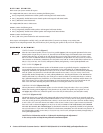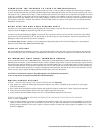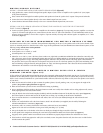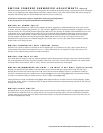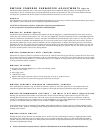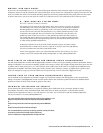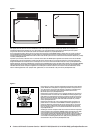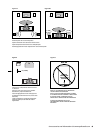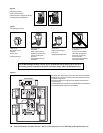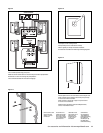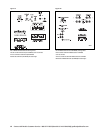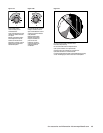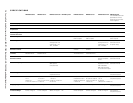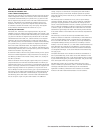
4 Contact Polk Audio Customer Service 1-800-377-7655 (Outside US: 410-764-5266), polkcs@polkaudio.com
RM7600 HOOKUP OPTIONS
OPTION 1—SPEAKER WIRE HOOKUP, OUR FAVORITE HOOKUP METHOD (Figure 8):
Using Speaker Wire, connect the left and right front speaker outputs of your receiver or amplifier to the “speaker level” (wire) inputs
of the powered subwoofer.
Then, connect the left and right front satellite speakers with speaker wire from the “speaker level” outputs of the powered subwoofer.
Connect the Center Channel Speaker directly to the center channel output from your receiver.
Connect the Rear Surround Satellites directly to the rear or surround channel outputs from your receiver.
OPTION 2—LINE LEVEL HOOKUP, USED WITH ELECTRONICS THAT HAVE PRE-OUT JACKS FOR THE LEFT AND RIGHT
FRONT CHANNELS (Figure 9):
Connect your front speakers to your receiver or amplifier in the normal way (Figure 8). If your pre-amp, processor, amplifier or receiver has
a spare set of front left and right pre-outs, connect them to the Line Level “In” jacks of the subwoofer. Use well-shielded RCA cables. If your
pre-amp, processor, amplifier or receiver has a single set of pre-outs and they are being used to deliver signal to an amplifier, use “Y” cables
as shown in (Figure 9).
RECEIVER SET-UP/BASS MANAGEMENT FOR RM7200 & RM7600 SYSTEMS
All surround receivers allow you to “customize” their performance depending on the size of your speakers. Refer to the owner’s manual of your
receiver or surround processor to learn how this is done. To get the best performance from your RM7000 Series Home Theater Systems, use the
following settings with the above hook-up methods:
Front speakers—set to “large”
Center speaker—set to “normal” or “small”
Surround speakers—set to “small”
Subwoofer—set to “OFF” or “none.” (We know; doesn’t make sense, right? Both your RM7200 and RM7600 have subwoofers. But really truly,
this is the correct setting for the recommended Speaker Wire and Line Level hookup methods. In the Speaker Wire Hookup, setting the front
left and right speakers to “Large” and routing them through the subwoofer’s low pass filter delivers a full range signal to the subwoofer’s
low pass filter. The low pass filter takes the low frequencies and passes the rest on to the front speakers, for perfect sub/sat blending. In the
Line Level Hookup, setting the front left and right speakers to “Large” and choosing subwoofer “OFF” directs all the bass and LFE channel
information to the subwoofer via the left and right pre-amp outputs.)
WALL-MOUNTING YOUR RM7200 & RM7600 SATELLITES & CENTER
CHANNEL SPEAKER (Figures 10–12)
All five satellites of both the RM7200 and RM7600 Systems have integrated wall-mounting brackets built onto the rear of each speaker. On-wall
installation of these RM speakers requires basic skills and basic tools (drill and screwdriver). If you are in doubt that you possess the necessary
skills or tools, consult your Polk dealer or a professional installer. Otherwise, follow the steps below to safely secure the speakers to the location
of your choice.
Make sure the material on which you plan to mount the speakers (plaster, drywall, paneling, stone, etc.) can support the weight of the
speakers (See product weight specifications on page 14).
Make sure the locations you select do not conceal electrical wiring or plumbing.
Prior to installation, hold the speaker in the chosen location to make sure it safely clears obstacles such as ceiling, adjacent walls, corners,
beams, lighting fixtures and door/window frames.
Using the keyhole slots in the bracket template (included), mark the installation location of the keyhole slots with a pencil (Figure 10).
Orient the template so that the small ends of the keyhole slots are facing “up” according to the direction of installation.
If you are certain that there is a stud behind the wall surface, drive #10 screws (not included) through the wall and into the stud
(Figure 11a).
If there is no stud behind the wall at the chosen location, install #10 wall anchors (not supplied) into the wall by following the
wall-anchor-manufacturer’s instructions (Figure 11b).
For masonry walls, use a masonry drill bit and #10 masonry anchor and screw (not included).
Tighten screws into stud or wall anchors, leaving screw heads protruding 1/16" (1.6mm).
Line up the keyhole slots on the bracket so that the screw heads pass through the large center hole of the slots.
Let the speaker slide straight down, allowing the screw head to slip behind the smaller end of the keyhole slot (Figure 12).
Tug gently on the speaker to make certain that the screws and bracket are properly aligned and that the wall anchors are secure.
If the bracket is not held snug against the wall by the screw heads, remove the speaker from the wall, drive the screws in a little further
and then remount the speaker.




